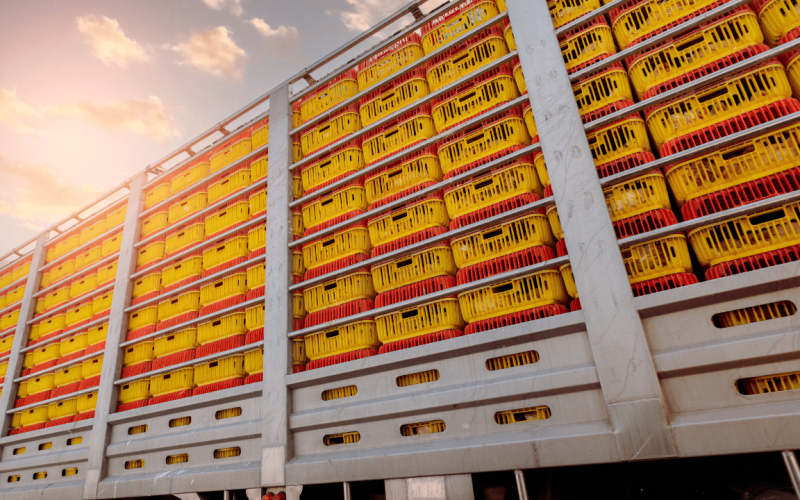Starting a livestock transportation company is an exciting but complex venture with many regulations and moving parts.
Transporting live cargo requires specialized equipment, licensing, insurance, and experienced staff to properly handle animals and ensure their well-being during transit.
A livestock transportation company can be rewarding for the right entrepreneur with a passion for animal husbandry and logistics.
This guide will walk you through all the steps to get your own livestock transportation business in the USA.
How to Start a Livestock Transportation Company
Starting a livestock transportation company can be rewarding if you have a passion for animals and driving.
Here are the basics to get you on the road:
1. Determine the Livestock Transportation Services You Want to Offer
To start a livestock transportation company, you’ll need to figure out what kinds of animals you want to transport.
Do you want to focus on cattle, hogs, chickens, horses, or a mix? Each type requires different equipment, skills, and considerations.
- You’ll need heavy-duty trucks, sturdy trailers, and experienced handlers for cattle or hogs.
- Transporting poultry requires specially-designed coops and an understanding of proper temperature control.
- Horse transport demands trailers with stalls, non-slip flooring, and staff knowledgeable about equines.
A good approach is to start with one or two types of livestock and expand from there as your business grows.
Maybe you have experience with cattle from working on a ranch or grew up around horses. Use that knowledge to your advantage!
Read Also: Beginner’s Guide to Choosing the Best Red Wine
2. Obtain the Necessary Licenses and Permits
To legally operate a livestock transportation company in the U.S., you’ll need to obtain the proper licenses and permits.
The specific requirements vary in each state, so check with your local Department of Agriculture for details.
Commercial Driver’s License (CDL)
Obtain a CDL with the proper endorsements for hauling livestock if you plan to drive livestock trucks.
You’ll need a Class A or B CDL with a “T” endorsement for double or triple trailers. Some states require additional testing or permits for livestock hauling.
Business Licenses
Register your business and obtain licenses or permits to operate legally. You may need a general business license or permit and additional ones for transportation or agriculture.
Fees range from $50 to $500 annually, depending on your location and business structure.
USDA Licensing
Hauling livestock across state lines requires a USDA license, which involves an application process and inspection of your equipment and facilities.
USDA licensing helps ensure the humane and sanitary transportation of animals in interstate commerce.
Insurance
Liability insurance protects you from accidents, injuries, or other issues. Get commercial auto insurance for your vehicles and general liability coverage for your business.
Additional endorsements like motor truck cargo insurance will cover the livestock you haul.
3. Secure the Proper Livestock Transportation Equipment
To transport livestock, you’ll need the proper equipment. Investing in high-quality gear designed specifically for livestock transportation will help ensure the safety, security, and comfort of the animals in your care.
Trailers
The most essential piece of equipment is a livestock trailer. Look for a trailer designed explicitly for hauling cattle, pigs, sheep, goats, or whatever animal you transport.
Trailers come in various sizes, so choose one appropriate for your needs. Consider features like non-slip flooring, ventilation, padding, and partitions.
Ensure any trailer you purchase is in good working order and rated to safely transport the maximum load you need. Perform routine maintenance to avoid issues while on the road.
Ramps and Chutes
Loading and unloading animals can be challenging without the proper equipment. Look for a trailer with a built-in ramp, or purchase portable ramps and chutes.
These make it easier to guide animals into and out of the trailer. For larger animals like cattle, a squeeze chute can help restrain them for loading and unloading.
Moveable partitions are also helpful in controlling animal movement.
Additional Supplies
Don’t forget other necessities like food and water troughs, bedding like straw or wood shavings, emergency veterinary supplies, cleaning and sanitation products, and anything specific to the type of animal you transport.
Your goal should be to make the transport process as stress-free as possible for the animals.
Provide for all their basic needs to keep them safe, healthy, and comfortable during transit.
4. Hire Qualified and Experienced Drivers and Staff
Having the right team is essential to run a successful livestock transportation company. This includes qualified, experienced drivers and helpful office staff.
Hire Qualified and Experienced Drivers
Your drivers will be responsible for safely transporting livestock, so look for those with a commercial driver’s license (CDL) and experience hauling live cargo.
Check references to ensure they have a proven track record of responsible driving and properly caring for animals during transit.
Offer thorough training to familiarize new hires with your company’s policies and procedures.
Go over things like loading/unloading livestock, ensuring their health and comfort during the trip, cleaning the trailer after delivery, and properly maintaining the vehicle.
Provide hands-on mentorship by pairing new drivers with more experienced ones.
- Conduct background checks, drug tests, and road tests before officially hiring anyone.
- Offer competitive pay and benefits to attract and retain the best drivers.
- Provide clear expectations about driving hours, rest periods, and schedules to keep your drivers safe and compliant with regulations.
Staff Your Office
You’ll also need office staff to handle tasks like scheduling pickups and deliveries, billing clients, managing paperwork, and general administrative duties.
Look for candidates with organizational and communication skills, as they will interact frequently with drivers, clients, and the animals’ owners.
- Make sure office staff also receive proper training to do their jobs effectively. Explain company policies, billing procedures, scheduling processes, and any software they will use.
- Consider hiring an office manager to oversee the administrative side of the business. They can ensure the office runs smoothly so you can focus on other areas.
5. Market Your Livestock Transportation Company
After setting up your business, you must ensure people know your company.
Here are ways to effectively market your livestock business:
Build a Website
You’ll need an informative website to market your livestock transportation company effectively. Include details about your services, equipment, routes, and rates.
Share photos of your trucks, drivers, and any certifications or awards. List your contact information prominently and make it easy for customers to get a quote or book your services.
Read Also: 10 Vital Tips on How to Become a Professional Footballer
Start Social Media Profiles
Create business profiles on Facebook, Instagram, and LinkedIn to raise awareness of your company.
Post updates about your services, share photos and videos and engage with followers and potential customers.
Build your social media following through regular posts, advertising, and participating in relevant Facebook Groups and LinkedIn discussions.
Join Industry Organizations
Become a member of organizations like the Livestock Marketing Association or National Livestock Producers Association.
Attend local chapter meetings to network, pass out your business cards, and look for opportunities to sponsor or advertise.
You’ll gain valuable insight into the latest regulations and trends in the livestock transportation industry. Membership also adds credibility to your business.
Advertise Strategically
Place ads on websites and in publications that your target customers frequent, such as farming and livestock equipment retailers, feed stores, and auction yards.
Sponsor local 4-H Clubs, Future Farmers of America chapters, rodeos, or county fairs.
Put your company name and logo on your trucks, trailers, uniforms, website, and social media to increase brand visibility.
Offer Promotions and Discounts
Run special limited-time promotions and discounts to attract new customers, especially when starting your business.
For example, offer 10% off first-time customers or a free quote. You can also provide discounts and reward programs for loyal repeat customers to keep them returning.
Promoting your new livestock transportation company through multiple channels will help establish your brand, build awareness, and win new customers.
You’ll gain industry recognition as a trusted name with time and consistency.
FAQ
What Qualifications Are Necessary to Start a Livestock Transportation Company?
You will need a commercial driver’s license (CDL) permit to drive commercial trucks transporting livestock to operate a livestock transportation company.
Depending on the state, additional licenses like a weighmaster license or hazardous materials endorsement may be necessary for transporting specific livestock or materials.
What Equipment Is Required to Start This Business?
To start a livestock transportation business, you will need specially designed trailers or trucks for safe transport.
These trailers should be well-ventilated and equipped with non-slip coatings.
Additionally, adequately secured troughs and hay nets are essential for ensuring the animals’ safety during transportation.
Are There Any Special Regulations for Transporting Livestock?
Transporting livestock across state lines requires special permits and documentation from the Department of Transportation.
Each state may also have additional regulations that must be followed. It is crucial to stay informed about all relevant regulations on the specific type of livestock you intend to transport.
What Type of Insurance Is Necessary?
You must obtain liability and cargo insurance to protect your business from potential claims or damages during transit.
Motor vehicle insurance may also be required to cover damages resulting from accidents.
What Safety Precautions Should Be Taken During Livestock Transportation?
Implementing safety measures to protect the animals from harm, prevent disease transmission, and ensure their well-being is essential.
Safety measures include;
- Animals secure confinement
- Provision of adequate food and water,
- Proper ventilation.
- Ensure temperature control of the vehicle
What Is the Average Salary for Livestock Truck Drivers?
Salaries for livestock truck drivers can vary depending on experience and the employing company.
On average, a livestock truck driver earns approximately $40,000 per year.
Conclusion
You can turn your love of animals into a thriving livestock transportation company with hard work and dedication.
It’ll take some time and patience, but if you have a passion for the industry and serving farmers and ranchers, the reward will be well worth the effort.
Remember, start small and build up as you gain experience and customers. Focus on high-quality service, safe and humane transportation practices, and building strong relationships.
With hard work and persistence, you’ll be well on your way to growing a successful business in this vital industry.









